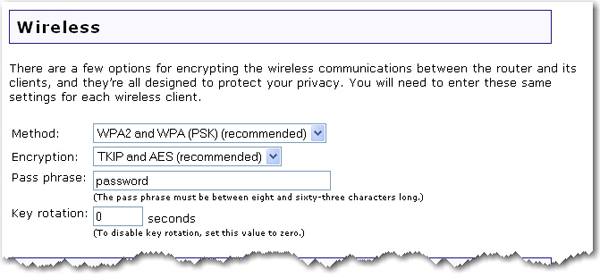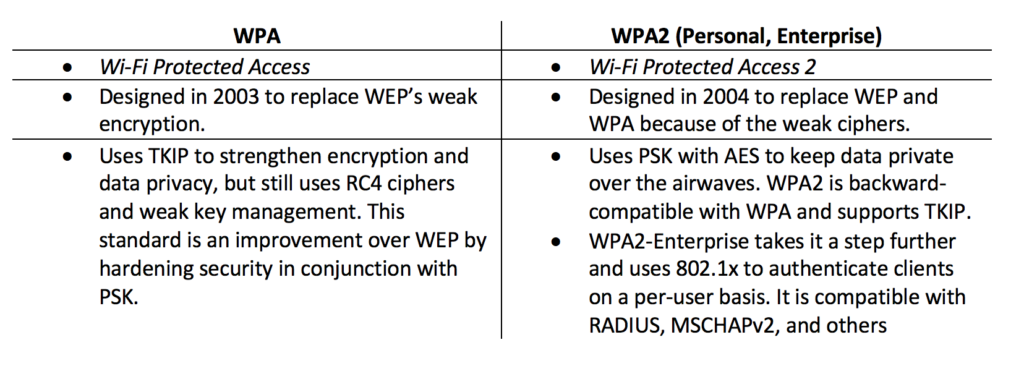

It has been superseded by WPA2 and isn’t secure. WPA-PSK (TKIP): This uses the original version of the WPA protocol (essentially WPA1).

It isn’t really any less vulnerable than WEP 64. WEP 128 (risky): This is WEP, but with a larger encryption key size.WEP 64 (risky): The old WEP protocol standard is vulnerable and you really shouldn’t use it.You shouldn’t set up an open Wi-Fi network-seriously, you could have your door busted down by police. Open (risky): Open Wi-Fi networks have no passphrase.
#Wep vs wpa psk tkip password#
RELATED: Why You Shouldn't Host an Open Wi-Fi Network Without a Password Here are the options you’re likely to see on your router: But all you really need to do is hunt down the one, most secure option in the list that works with your devices. Wi-Fi Security Modes ExplainedĬonfused yet? We’re not surprised. This distinguishes it from WPA-Enterprise, which uses a RADIUS server to hand out unique keys on larger corporate or government Wi-Fi networks. RELATED: Warning: Encrypted WPA2 Wi-Fi Networks Are Still Vulnerable to SnoopingĪnd in case you’re wondering, the “PSK” in those names stands for “ pre-shared key” - the pre-shared key is generally your encryption passphrase. However, on devices without a visible “TKIP” or “AES” option, WPA2 is generally synonymous with WPA2-AES. In such a state, devices that support WPA2 will connect with WPA2 and devices that support WPA will connect with WPA. While WPA2 is supposed to use AES for optimal security, it can also use TKIP where backward compatibility with legacy devices is needed. But, depending on your router, just choosing WPA2 may not be good enough. AES is a newer Wi-Fi encryption solution used by the new-and-secure WPA2 standard. The short version is that TKIP is an older encryption standard used by the WPA standard. RELATED: Brute-Force Attacks Explained: How All Encryption is Vulnerable AES is generally considered quite secure, and the main weaknesses would be brute-force attacks (prevented by using a strong passphrase) and security weaknesses in other aspects of WPA2. For example, when you encrypt a hard drive with TrueCrypt, it can use AES encryption for that.

It’s a serious worldwide encryption standard that’s even been adopted by the US government. AES isn’t some creaky standard developed specifically for Wi-Fi networks, either. In other words, you shouldn’t be using it.ĪES is a more secure encryption protocol introduced with WPA2. TKIP is no longer considered secure, and is now deprecated. TKIP is actually quite similar to WEP encryption. TKIP is actually an older encryption protocol introduced with WPA to replace the very-insecure WEP encryption at the time. TKIP is no longer considered secure, and is now deprecated.TKIP and AES are two different types of encryption that can be used by a Wi-Fi network. TKIP stands for “Temporal Key Integrity Protocol.” It was a stopgap encryption protocol introduced with WPA to replace the very-insecure WEP encryption at the time. What does TKIP stand for in wireless networking? But, depending on your router, just choosing WPA2 may not be good enough. In summary, TKIP is an older encryption standard used by the old WPA standard. WPA uses TKIP encryption, WPA2 uses AES, but can also use TKIP for backward-compatability (so it would accept WPA connections). WPA and WPA2 encryption standards can sometimes be confusing. Tags: TKIP, AES, WPA2, WPA, Wireless security, encryption. What’s the difference between WPA and TKIP encryption? As the WiFi Alliance made this transition to a more advanced protocol, they had to keep some of the same elements of WEP so older devices would still be compatible. WPA uses Temporal Key Integrity Protocol (TKIP) for more secure encryption than WEP offered. Using some encryption is always better than using none, but WEP is the least secure of these standards, and you should not use it if you can avoid it. WEP stands for Wired Equivalent Privacy, and WPA stands for Wireless Protected Access. WPS doesn’t use encryption - and can actually bypass whatever encryption might otherwise be in use! How does WPA2 different from Wired Equivalent Privacy? WPA2 uses a stronger encryption technology that’s immune to most forms of hacking. WPA is mostly obsolete because it uses an older encryption technology that’s now relatively easy to crack. Then it dynamically varies the encryption key. WPA2-PSK uses a passphrase to authenticate and generate the initial data encryption keys. WPA2-PSK gets higher speed because it is usually implemented through hardware, while WPA-PSK is usually implemented through software. What is the difference between WPA PSK TKIP and WPA2-PSK AES? What is better WPA-PSK or WPA2-PSK?


 0 kommentar(er)
0 kommentar(er)
